Sunday, October 22, 2006
Disaster
My poor vegetables were wiped out by the brief but unusually strong storm last month. The only thing that survived were some Japanese eggplants which I'm harvesting today. Its such a pity and I was devastated. I won't be posting as often until I have more produce. So in the meantime you can check my other, recently created, blog - still about food of course.
Friday, August 11, 2006
Postcards From Vienna

In my last post I joined the Blogger Postcards of the World exchange and yesterday I got some in my mail. What a pleasant surprise to find not one but 4 postcards from my secret sender. Johanna of The Passionate Cook wrote all about her homeland Vienna although she lives in London. I love to travel and discover new things and places so her write up was much appreciated. I must admit Vienna was not one of my list of places to visit and that's because I didn't know much about it. Thank you Johanna for sparking an interest in me. Vienna has much to offer in the way of culture and architecture which spans from the Baroque period to the present modern day. It is the birthplace of Johann Strauss, whose music, according to Johanna, "embodies everything that is Vienna and the Viennese". She adds, that the Viennese concert every New Year is transmitted to over 40 nations. I will certainly try to catch that this New Year's. What a wonderful thing! Johanna also wrote about Vienna's coffee culture. I do love hanging out in cafes and I do have an awful sweet tooth for good pastry. She writes that the foremost intellectuals 100 years ago use to spend hours lingering in cafes over a cup of coffee, sharing thoughts. Nowadays, friends gather in cafes for coffee, pastry and chatting. Not a bad idea. Johanna shall I meet you there someday?
Thursday, August 03, 2006
Blogger Postcards From The World Event
Meeta from blog What's For Lunch Honey? has come up with a fun blog event wherein each participant sends and recieves a post card from a randomly picked blogger. Here's my postcard...

I took this picture a month ago while attending an organic food convention in Bacolod. This creek runs through my cousin's 100 hectare land which he converted from agricultural land to a wildlife sanctuary. Indegenous trees were planted about 10 years ago when this property was stripped bare. See how lush it is now?

I took this picture a month ago while attending an organic food convention in Bacolod. This creek runs through my cousin's 100 hectare land which he converted from agricultural land to a wildlife sanctuary. Indegenous trees were planted about 10 years ago when this property was stripped bare. See how lush it is now?
Wednesday, July 26, 2006
Recipe: Prawn with Chives & Fenugreek Leaves

Adapted from the cookbook 50 Great Curries of India by Camelia Panjabi. The book failed to say that the vegetables needed draining so I went ahead and added the whole bowl of soaking chives and methi (fenugreek leaves). I then added cream to the dish because I felt the dish needed it. If you want a dry dish, which would be the case if done correctly, drain the soaking chives and methi before adding it to the pan and omit the cream. Although I have to say, this version turned out pretty good.
1 1/2 cups chopped chives
2 tablespoons dried methi, crushed fine
3/4 teaspoon salt
3/4 teaspoon turmeric powder
1/4 teaspoon chili powder
1 tablespoon calamansi or lemon or lime juice
400 grams shelled prawns
3 tablespoons virgin coconut oil or vegetable oil
1 - 2 jalapeno chilies
4 large cloves garlic
1 inch piece ginger
1/4 cup cream
*3/4 cup coriander leaves
Soak the chives, methi and salt in a bowl of water. In another bowl add the turmeric, chili powder and calamansi juice and marinate the prawns for about 30 minutes.
Chop jalapeno, garlic and ginger in food processor. Saute this mixture in oil. Add 1 tablespoon water. Add (drained) chives mixture and cook 5 minutes. Add the prawns, just before serving, and cook another 5 minutes. Mix in cream.
*the original recipe called for coriander and was added with the chives
Monday, July 24, 2006
Quote Of The Day
If you want to make an apple pie from scratch, you must first create the universe.
Carl Sagan
Carl Sagan
Friday, July 21, 2006
Environmental Booklist
Environmental issues are all over the news media. To get a better grasp of what the issues are all about I would recommend reading more on the topic. But where to start? The Environmental Defense Fund has come out with their new booklist. The book Natural Capitalism: Creating the Next Industrial Revolution by Paul Hawken, et al. looks interesting. Can capitalism walk hand in hand with environmentalism?
If there is one book I personally recommend it is Silent Spring by Rachel Carson. Although set in the 50's rural America and first published as a series in the New Yorker in 1962, the story she tells is a global one and a story that still continues today in Asia. RC writes with eloquence, making complicated scientific theories easy to understand. I was engrossed with this book which was text book reading in one of my Environmental Studies courses. The new edition has a forward by Al Gore who was himself changed as a young man after reading the book when it first came out.
If there is one book I personally recommend it is Silent Spring by Rachel Carson. Although set in the 50's rural America and first published as a series in the New Yorker in 1962, the story she tells is a global one and a story that still continues today in Asia. RC writes with eloquence, making complicated scientific theories easy to understand. I was engrossed with this book which was text book reading in one of my Environmental Studies courses. The new edition has a forward by Al Gore who was himself changed as a young man after reading the book when it first came out.
Rachel Carson made environmentalism respectable. Before Silent Spring, nearly all Americans believed that science was a force for good. Carson's work exposed the dark side of science. It showed that DDT and other chemicals we were using to enhance agricultural productivity were poisoning our lakes, rivers, oceans, and ourselves. Thanks to her, progress can no longer be measured solely in tons of wheat produced and millions of insects killed. Thanks to her, the destruction of nature can no longer be called progress.
- Ecotopia
Thursday, July 20, 2006
Philippine Birds
As I was surfing the net looking for possible names for a new company I'm forming I came across Romy Ocon's website of Philippine birds. He truly captures the beauty of these wonderful animals, many of which are endemic. At the same time I am saddened by the thought that these birds are swiftly loosing their habitat because of urban sprawl, illegal logging and mining operations. Endemic birds are the most worrisome because they are found only in the Philippines
There are organizations like Haribon Foundation that advocate biodiversity conservation. So all is not lost, but certainly these organizations need the support of communities and individuals to help save these animals from becoming endangered. So go out there and take action!
Here are some of my favorite photos.

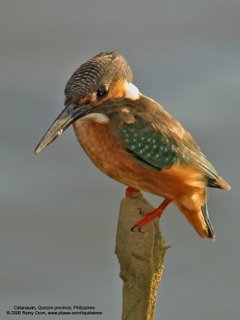

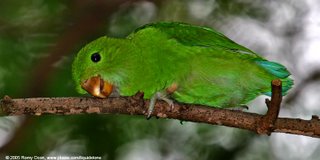

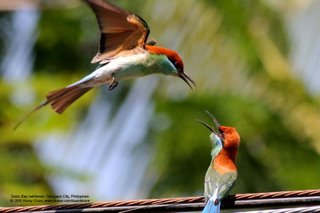
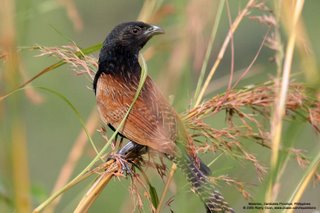
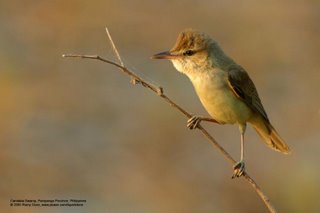

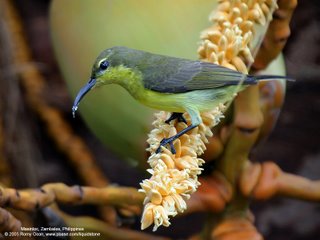

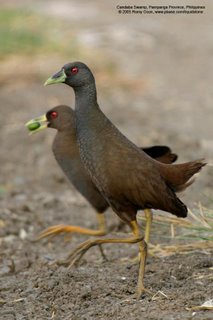
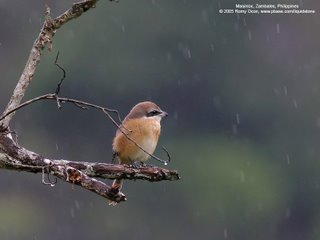

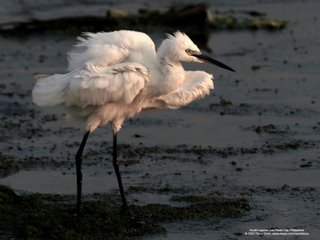






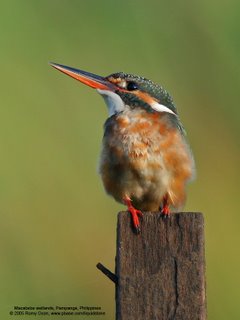




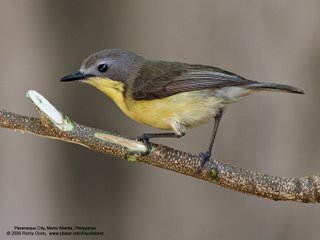



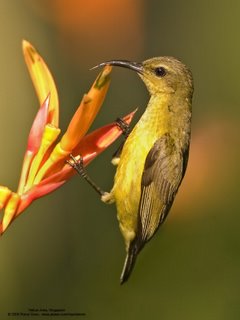


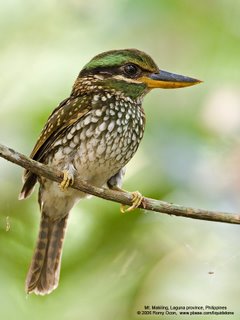
There are organizations like Haribon Foundation that advocate biodiversity conservation. So all is not lost, but certainly these organizations need the support of communities and individuals to help save these animals from becoming endangered. So go out there and take action!
Here are some of my favorite photos.


































Saturday, July 15, 2006
Mixology Monday V: Lemon
Lemon is the main ingredient for this month's Mixology Monday hosted by Jiggle The Handle. At first I thought of making a Lemon Drop cocktail but that was too obvious. So I searched for something else, a drink that had some mystery. The name of this drink caught my attention. I even found a song that goes with it.
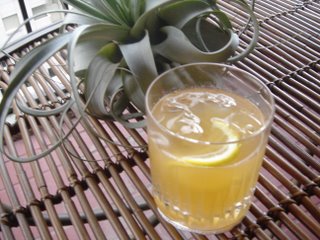
A Night In Old Mandalay
A very refreshing drink that would go perfectly with barbeque.
1 oz Tanduay rum
2 oz Añejo Tanduay rum
2 oz Orange juice
1 oz Lemon juice
6 oz Ginger ale
2 twists of Lemon peel
In a shaker half-filled with ice cubes, combine the light rum, añejo rum, orange juice, and lemon juice. Shake well. Strain into a highball glass almost filled with ice cubes. Top with the ginger ale. Garnish with the lemon twist.

A Night In Old Mandalay
A very refreshing drink that would go perfectly with barbeque.
1 oz Tanduay rum
2 oz Añejo Tanduay rum
2 oz Orange juice
1 oz Lemon juice
6 oz Ginger ale
2 twists of Lemon peel
In a shaker half-filled with ice cubes, combine the light rum, añejo rum, orange juice, and lemon juice. Shake well. Strain into a highball glass almost filled with ice cubes. Top with the ginger ale. Garnish with the lemon twist.
Nelly The Elephant
To Bombay
A travelling circus came
They brought an intelligent elephant
and Nellie was her name
One dark night
she slipt her iron chain, and of she ran
to Hindustan and was never seen again
oooooooooooooooooo...
Nellie the elephant pack her trunk and
said goodbye to the circus
of she rode with a trumety trump
trump trump trump
Nellie the elephant packed her trunk
and trumbled of to the jungle
of she road with a thrumety trump
trump trump trump
Night by night she danced to the circus band
When Nellie was leading the big parade she looked
so proud and grand
No more tricks for Nellie to perform
They taught her how to take a bow and she took
to crowd by storm
oooooooooooooooooo...
Nellie the elephant pack her trunk and
said goodbye to the circus
of she rode with a trumety trump
trump trump trump
Nellie the elephant packed her trunk
and trumbled of to the jungle
of she rode with a thrumety trump
trump trump trump
The head of the heard was calling far far away
they met one night in silver light
on the road to Mandalay
oooooooooooooooooo...
Nellie the elephant pack her trunk and
said goodbye to the circus
of she road with a trumety trump
trump trump trump
Nellie the elephant packed her trunk
and trumbled of to the jungle
of she road with a thrumety trump
trump trump trump
To Bombay
A travelling circus came
They brought an intelligent elephant
and Nellie was her name
One dark night
she slipt her iron chain, and of she ran
to Hindustan and was never seen again
oooooooooooooooooo...
Nellie the elephant pack her trunk and
said goodbye to the circus
of she rode with a trumety trump
trump trump trump
Nellie the elephant packed her trunk
and trumbled of to the jungle
of she road with a thrumety trump
trump trump trump
Night by night she danced to the circus band
When Nellie was leading the big parade she looked
so proud and grand
No more tricks for Nellie to perform
They taught her how to take a bow and she took
to crowd by storm
oooooooooooooooooo...
Nellie the elephant pack her trunk and
said goodbye to the circus
of she rode with a trumety trump
trump trump trump
Nellie the elephant packed her trunk
and trumbled of to the jungle
of she rode with a thrumety trump
trump trump trump
The head of the heard was calling far far away
they met one night in silver light
on the road to Mandalay
oooooooooooooooooo...
Nellie the elephant pack her trunk and
said goodbye to the circus
of she road with a trumety trump
trump trump trump
Nellie the elephant packed her trunk
and trumbled of to the jungle
of she road with a thrumety trump
trump trump trump
Roundup 1 - lemon mixology
Roundup 2 - lemon mixology
Thursday, July 13, 2006
Recipe: Apple & Walnut Cake
I adapted this recipe from Nigela Lawson's "How To Be A Domestic Goddess". The cake can be baked in a round cake pan as well. It is so good we've been having it everyday. This cake can keep for about 5 days without refrigeration. I suggest its eaten before then because the consistency of the cake changes when refrigerated, it becomes pasty and dense. The fresh cake is moist, airy and utterly delicious!

7 tablespoons raisins
75 ml water [or rum]
150 ml extra-virgin coconut oil [can use walnut oil or olive oil]
14 tablespoons muscovado sugar [can use white sugar]
2 large eggs
1 1/4 cup + 1 tablespoon AP flour
1 teaspoon cinnamon
1 1/2 teaspoons baking soda
1/2 teaspoon cream of tartar
1/2 teaspoon salt
2 (450 grams) apples, peeled, cored and cut into small dice
7 tablespoons chopped walnuts
Bring the water and raisins to a boil, remove from heat and set it aside to macerate.
Preheat oven to 180 degrees C. Butter and flour a loaf pan or 9" cake pan.
Beat sugar and oil in a bowl, add eggs one at a time and continue beating until lightly thickened. Fold in the dry ingredients, then the apples, drained raisins and walnuts. Pour the thick batter into the prepared pan, smooth the top and bake for 1 hour.

7 tablespoons raisins
75 ml water [or rum]
150 ml extra-virgin coconut oil [can use walnut oil or olive oil]
14 tablespoons muscovado sugar [can use white sugar]
2 large eggs
1 1/4 cup + 1 tablespoon AP flour
1 teaspoon cinnamon
1 1/2 teaspoons baking soda
1/2 teaspoon cream of tartar
1/2 teaspoon salt
2 (450 grams) apples, peeled, cored and cut into small dice
7 tablespoons chopped walnuts
Bring the water and raisins to a boil, remove from heat and set it aside to macerate.
Preheat oven to 180 degrees C. Butter and flour a loaf pan or 9" cake pan.
Beat sugar and oil in a bowl, add eggs one at a time and continue beating until lightly thickened. Fold in the dry ingredients, then the apples, drained raisins and walnuts. Pour the thick batter into the prepared pan, smooth the top and bake for 1 hour.
Wednesday, July 12, 2006
A Forest Oasis Amidst the Farmlands

Tabukol is a wonderful oasis in Negros, one of the Philippine plantation capitals of the country, and a sanctuary for endangered endemic wildlife such as the Visayan Taritic Hornbill and Philippine Leopard Cat. Tabukol was once a dry, barren land before the Sagemullers reforested and consequently brought back to life a natural spring which now irrigates the farmlands that sprouted in the area. It took about 10 years for the forest to regenerate. Not bad and a prime example of the viability of reforestation. A great article in the Inquirer this week tells us more. An important thing to note is in order to successfully reforest an area one must keep in mind the use of native species.
I do wish more reforestation would happen in idle land. Aside from the environmental aspect of reforestation there is a social aspect as well. The two almost always goes hand in hand.
Monday, July 10, 2006
The Spice Is Right 4: Its Too Darn Hot: Chilis
July is both a hot and rainy month. The humidity sometimes feels like your wrapped in a hot wet blanket! I do love the rain though. The best thing about the sultry weather are days when it rains early in the morning and you wake up to a clear sunny day and everything looks fresh and clean.
For this months theme of The Spice Is Right, I made something hot and sticky to match the weather. I adapted this delicious jam from Lex Culinaria.

Spicy Onion Jam
2 lagre red onions chopped (about 5 cups)
1 + 1/4 cup golden sugar
2 teaspoons white peppercorns or 1 teaspoon red pepper flakes
1 teaspoon cumin seeds
1 + 1/2 cups red wine vinegar
1 cup water
1/4 cup tomato paste
1 +1/2 tablespoons cornstarch dissolved in 1/2 cup cold water
Place onions in a large saucepan and saute over medium heat for 5- 10 minutes, stirring constantly until onions begin to soften and sweat. Add remaining ingredients, except cornstarch/water mixture, and bring to a simmer. Simmer for 10 - 15 minutes or until flavours are well blended and onions are fairly soft, but retain some crunch. Stir through cornstarch mixture and cook a couple of minutes more. Pour into clean hot jars. Loosely apply lids and set aside to cool. When cool, tighten lids and refrigerate. Jam should keep in the fridge for 4 to 6 weeks. Serve with cream cheese and crackers.
Makes 5 x 250ml jars.

Roundup Part 1
Roundup Part II
Roundup Part III
For this months theme of The Spice Is Right, I made something hot and sticky to match the weather. I adapted this delicious jam from Lex Culinaria.

Spicy Onion Jam
2 lagre red onions chopped (about 5 cups)
1 + 1/4 cup golden sugar
2 teaspoons white peppercorns or 1 teaspoon red pepper flakes
1 teaspoon cumin seeds
1 + 1/2 cups red wine vinegar
1 cup water
1/4 cup tomato paste
1 +1/2 tablespoons cornstarch dissolved in 1/2 cup cold water
Place onions in a large saucepan and saute over medium heat for 5- 10 minutes, stirring constantly until onions begin to soften and sweat. Add remaining ingredients, except cornstarch/water mixture, and bring to a simmer. Simmer for 10 - 15 minutes or until flavours are well blended and onions are fairly soft, but retain some crunch. Stir through cornstarch mixture and cook a couple of minutes more. Pour into clean hot jars. Loosely apply lids and set aside to cool. When cool, tighten lids and refrigerate. Jam should keep in the fridge for 4 to 6 weeks. Serve with cream cheese and crackers.
Makes 5 x 250ml jars.

Roundup Part 1
Roundup Part II
Roundup Part III
Monday, July 03, 2006
Slow Food
I've just read a wonderful book called Slow Food: Philippine Culinary Traditions. The book is a compilation of essays written about culinary techniques and dishes of the past. The term "slow food" describes food that has been cooked from scratch using fresh local ingredients usually from the backyard or fresh from the sea, as opposed to fast food wherein food is highly processed and where one is unlikely to know its origins. The authors are all members of the Slow Food Movement that began in Italy and now has members from all over the world.
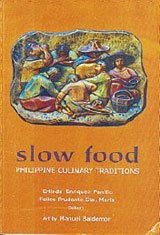
The essays are beautifully written, focusing on a particular type of food, province or family tradition and each providing a detailed recipe. It's interesting to note that there are some tastes and flavors that most provinces share. For example, sinigang is a dish you can find in any province. Yet each province has a particular fruit or vegetable indigenous to the area that is used to flavor this same dish. In Manila tamarind is the most commonly used ingredient to make the base of the soup. In Bacolod the native fruit batuan is used, others use guava, santol or calamansi. I myself happen to love it all! Although these are all different souring ingredients, each tastes different and brings a uniqueness to the dish.
The book shows how slow food is important in creating harmonious relationships with individuals, family and the environment because food and the way we cook and eat it permeates every aspect of our lives.

The essays are beautifully written, focusing on a particular type of food, province or family tradition and each providing a detailed recipe. It's interesting to note that there are some tastes and flavors that most provinces share. For example, sinigang is a dish you can find in any province. Yet each province has a particular fruit or vegetable indigenous to the area that is used to flavor this same dish. In Manila tamarind is the most commonly used ingredient to make the base of the soup. In Bacolod the native fruit batuan is used, others use guava, santol or calamansi. I myself happen to love it all! Although these are all different souring ingredients, each tastes different and brings a uniqueness to the dish.
The book shows how slow food is important in creating harmonious relationships with individuals, family and the environment because food and the way we cook and eat it permeates every aspect of our lives.
Sunday, July 02, 2006
Recipe: Santol Preserves
I managed to get the last batch of santol for the season from my cousins trees in Bacolod in order to make these delicious preserves.
Blanch whole santols in boiling water for about 10 minutes. Drain and peel. Quarter peeled santols and remove seeds. Place in a large bowl and cover with filtered water. Let it soak for 12 hours in the refrigerator. Drain and repeat 2 more times.
about 6 cups seedless diced santol
12 cups water
3 cups muscovado sugar
3 cups white sugar

Bring sugars and water to a boil. Add santol and simmer for about 3-4 hours. Let it cool.
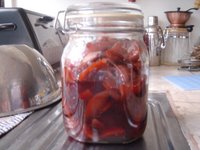
Place in clean bottles.
The preserves filled two bottles. Notice the syrup doesn't cover the santol? So I added rum to one bottle as an experiment...
Blanch whole santols in boiling water for about 10 minutes. Drain and peel. Quarter peeled santols and remove seeds. Place in a large bowl and cover with filtered water. Let it soak for 12 hours in the refrigerator. Drain and repeat 2 more times.
about 6 cups seedless diced santol
12 cups water
3 cups muscovado sugar
3 cups white sugar

Bring sugars and water to a boil. Add santol and simmer for about 3-4 hours. Let it cool.

Place in clean bottles.
The preserves filled two bottles. Notice the syrup doesn't cover the santol? So I added rum to one bottle as an experiment...
Friday, June 30, 2006
Recipe: Amaranth and Portabello Fettucine
I didn't take any measurements but I suspect this is a very forgiving recipe. I used green amaranth leaves which taste more like spinach than the purple ones. I'm glad my farm is overrun with 7 foot stalks of amaranth! The leaves are tasty, I'll be trying them in more recipes.
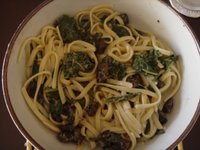
Amaranth leaves, stems removed and cut in about 1-inch pieces
portabello mushrooms, diced
garlic, chopped
butter
flour
milk
Parmesan cheese
fettucine
salt
Saute mushrooms and garlic in butter. Add amaranth, stir until wilted. Set aside.
In the same pan, add flour and equal amount of butter to make a roux (approximately 1/2 tablespoon each for a sauce serving 2 persons). Slowly add some warmed milk and whisk until thickened. Add amaranth mixture.
Boil fettucine in salted water. Add pasta to creamy amaranth mixture and heat until very hot, mixing constantly. Stir in some cheese. At this point the sauce may get too thick, thin pasta sauce by adding some of the salted water.
*Cooked amaranth leaves contain about 8% protein, 4% carbohydrates and are rich in calcium, iron and vitamins B and C in higher concentrations that spinach. For example, only 47 g of cooked leaves contains 100% of the minimum daily requirement of Vitamin C.

Amaranth leaves, stems removed and cut in about 1-inch pieces
portabello mushrooms, diced
garlic, chopped
butter
flour
milk
Parmesan cheese
fettucine
salt
Saute mushrooms and garlic in butter. Add amaranth, stir until wilted. Set aside.
In the same pan, add flour and equal amount of butter to make a roux (approximately 1/2 tablespoon each for a sauce serving 2 persons). Slowly add some warmed milk and whisk until thickened. Add amaranth mixture.
Boil fettucine in salted water. Add pasta to creamy amaranth mixture and heat until very hot, mixing constantly. Stir in some cheese. At this point the sauce may get too thick, thin pasta sauce by adding some of the salted water.
*Cooked amaranth leaves contain about 8% protein, 4% carbohydrates and are rich in calcium, iron and vitamins B and C in higher concentrations that spinach. For example, only 47 g of cooked leaves contains 100% of the minimum daily requirement of Vitamin C.
Lasang Pinoy #11: Summertime Coolers & Memories of Summer
Cool drinks are what I love in the summer, especially coconut juice and drinks with coconut milk. A last hoorah for the end of summer...

Batida
I first had this drink when I was living in Boracay (yes, I was actually living on this beautiful island beach resort) about 10 years back. Gosh! Has it been that long? I lived in a cottage fronting the white sand beach for two sun-kissed years. I would have this drink in the late afternoons just before the sun begins to set. This is actually a Brazilian drink but uses ingredients easily and commonly used in the Philippines. If I didn't know better I'd think this was a Pinoy creation. I have an ex-boyfriend to thank for this one, he substituted Tanduay rum for cachaca in the original recipe . I think he's still lounging in Boracay...
1 13.5-0z can coconut cream
filtered water
approximately 2 shots Tanduay rum
6 tablespoons muscovado sugar
ice cubes
Shake coconut cream, rum, 1 can of water and sugar in a bottle until sugar dissolves.
Fill shaker with ice cubes and cream mixture.
Pour into glasses and add ice cubes.

This is my entry for Lasang Pinoy #11 which is being hosted by JMom at In My Kitchen.

Batida
I first had this drink when I was living in Boracay (yes, I was actually living on this beautiful island beach resort) about 10 years back. Gosh! Has it been that long? I lived in a cottage fronting the white sand beach for two sun-kissed years. I would have this drink in the late afternoons just before the sun begins to set. This is actually a Brazilian drink but uses ingredients easily and commonly used in the Philippines. If I didn't know better I'd think this was a Pinoy creation. I have an ex-boyfriend to thank for this one, he substituted Tanduay rum for cachaca in the original recipe . I think he's still lounging in Boracay...
1 13.5-0z can coconut cream
filtered water
approximately 2 shots Tanduay rum
6 tablespoons muscovado sugar
ice cubes
Shake coconut cream, rum, 1 can of water and sugar in a bottle until sugar dissolves.
Fill shaker with ice cubes and cream mixture.
Pour into glasses and add ice cubes.

This is my entry for Lasang Pinoy #11 which is being hosted by JMom at In My Kitchen.
Bibingka for Breakfast
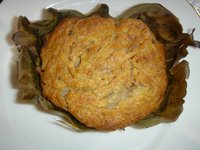
I came back a few days ago from a one week stay with cousins in Bacolod and brought back a large box full of goodies. In my opinion, Bacolod has some of the best food in the country. On this trip I tried original variations on local dishes. The bibinka from Sweet Greens Garden Cafe on 9th and Lacson Streets was amazing. Made by leaving the dough out to be naturally yeasted and cooked with the addition of makapuno instead of cheese. As I understand it, this bibinka is done the old way before commercial yeast or cheese was available, imparting the bibinka with another flavor dimension I can't quite describe. I placed it in the oven to be heated before eating it for breakfast this morning.
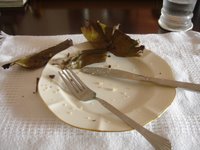
Subscribe to:
Posts (Atom)